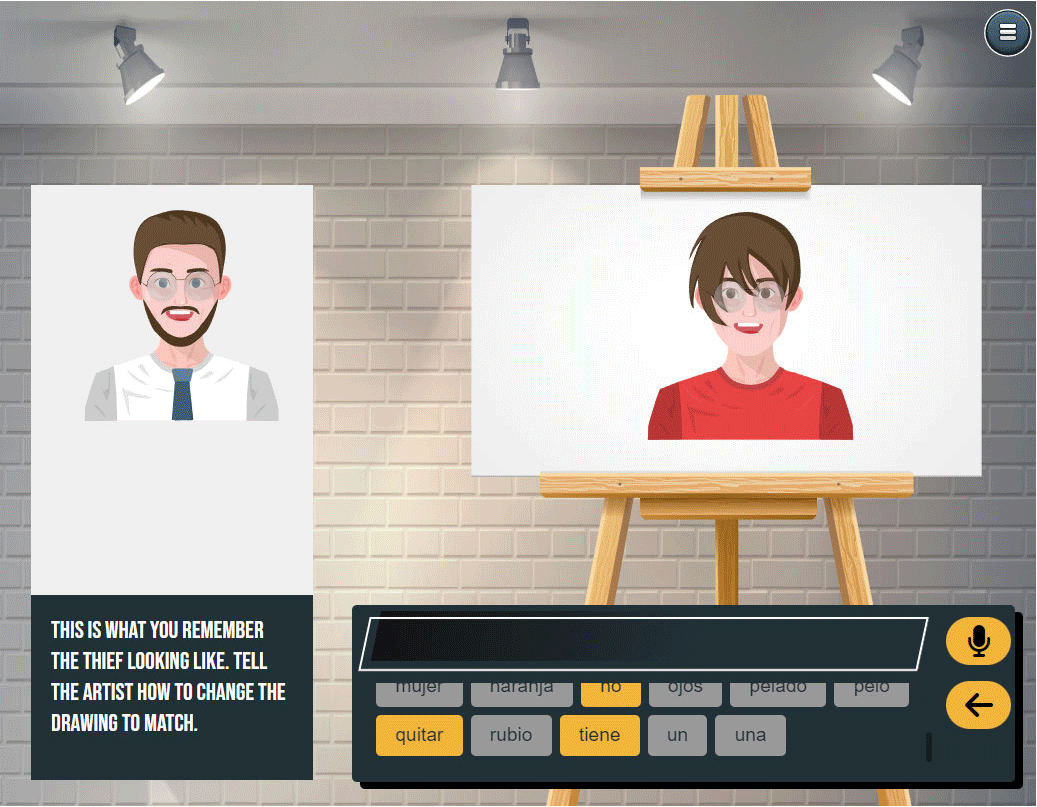




Elsewhere, he defines TBLT as having 4 key criteria:

In this exercise, students begin with a list of individual vocabulary words related to parts of the body. They then apply them to blanks provided next to different parts of a face.



If we re-examine the framework provided above, we can see how the tasks in Swirly Spanish align far better than would be possible with any worksheet assignment.
In the textbook assignment the goal presented is to fill in blanks with the associated Spanish word. There are no sentences created and no message being communicated
In the Swirly Spanish task, the goal is to communicate to a police sketch artist what the theif looked like. This is done by creating sentences which communicate meaning to the sketch artist. The artist then interprets those messages and performs a corresponding response
One of the most classic 'gap' exercises taught as the quintessential example of TBLT is a game that begins with students in pairs. One student is blindfolded and able to perform a physical task. The other is able to see, but, can not participate in the physical task; they can only interact with the blindfolded student verbally. This asymetry in abilities of the two students is what creates the 'gap.' The two of them must work together to have the blindfolded student navigate an obstacle successfully.
Playing Swirly Spanish requires the player to perform all the same linguistic challenges as the task above. The real student can only interact with their virtual character through verbal commands and instructions. Between the two of them, they must work together to complete the missions.
Every task within Swirly Spanish includes a menu with a palette of individual words and phrases. Learners are then required to take these components and use them to compose their own complete sentences. At any point, a student might have hundreds of different permutations for possible sentences they could choose to say. Thus, rather than selecting from a multiple-choice list, they must rely on their own linguistic resources to construct a sentence describing their intent. Whichever permutation a student ultimately chooses, the computer is programmed to respond and give feedback appropriately.
Every sentence a learner says generates a response by the game based on the meaning of that sentence. If a player tells the artist: "give him green eyes," they will then see the sketch change to have green eyes. If they intended to say: "give him blue eyes," they will recognize the need to repair their sentence, and the menu interface will scaffold them into making the correct selection. If they say: "give he blue eye" the artist will act confused, and a narrator will explain to the player why the artist is confused. The player is never told: "sorry, you failed because you didn't understand possessive pronouns correctly." While this may sound unimportant, research shows it has highly relevant affective outcomes in ultimate attainment for language acquisition.


(from How Languages are Learned)
First, let's differentiating between using grammar and describing grammar. Take a look at the two sentences below taken from a mission within the game:


You'll notice that the individual vocabulary used in the above sentences is 100% identical. Someone who had only learned the definitions of each word in these sentences would not be able to understand the difference between them. One can only understand the differences in meaning conveyed by using English grammar. By contrast, someone who has successfully learned to describe grammar would be able to tell you that, in English, "shared" is usually -- but not always -- a transitive verb. It can be used as either a monotransitive or ditransitive verb, either single or complex. When used as a ditransitive verb, it typically requires a direct object in the first slot and an indirect object in the secondary, but there can be exceptions depending on which assisting preposition is supplied.
Many language textbooks combine these two aspects of understanding grammar. Some students find it beneficial to be able to study both aspects simultaneously. However, it leaves behind other students who struggle with learning how to describe grammar and find it too overwhelming to do both simultaneously. Every activity in Swirly Languages involves constructing complete sentences and includes focus-on-form tools to ensure students learn to use any underlying grammatical concepts effectively. Students wishing to learn how to explicitly describe grammar are pointed to external resources they can follow based on their personal preferences. However, the focus within Swirly Languages is solely on using grammar. To that end, we cover numerous grammatical concepts and start introducing students to grammatical constructions typically reserved for much more advanced classes but in ways that still feel accessible even to beginner students.